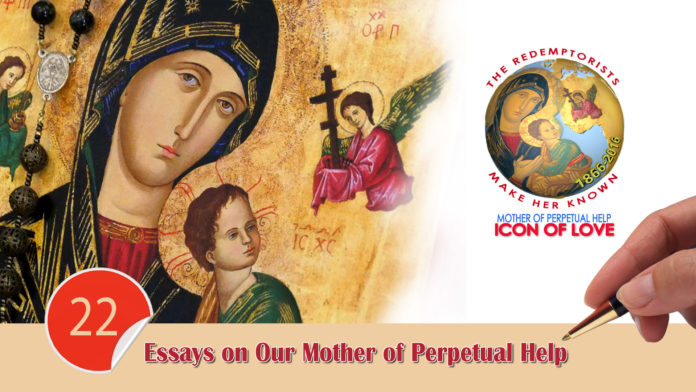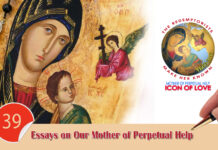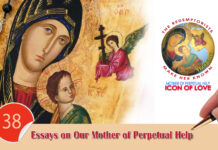In greeting Mary, Elizabeth recognized one of the key qualities of her cousin: Mary’s trust in God. As we meditate on the drama of our redemption, Mary’s trust stands out. Mary trusted God so deeply that she could say, “Behold the handmaid of the Lord,” in response to the angel’s confusing message and her own questions. Mary’s trust enabled the Holy Spirit to conceive the divine Son in her womb. In a sense, the fate of humanity depended on Mary’s agreement. Because she trusted, God could begin to implement the plan of redemption. In turn, Mary, with the Son of God in her womb, could allow the Holy Spirit to sanctify John the Baptist in Elizabeth’s womb.
We see Mary’s deep trust again at the marriage at Cana. Mary brushed aside Jesus’ excuses, and boldly told the waiters, “Do whatever he tells you.” (John 2: 5)
For one hundred fifty years, Redemptorists have treasured the icon of our Mother of Perpetual Help. As we reflect on this icon as a gift to us & to the world, we note that trust stands out in the picture itself, and inspires the devotion of millions of people to Mary as pictured in the icon.
Neo-Freudian psychoanalysts explain the primary importance of trust. Erik Erikson writes:
For the first component of a healthy personality, I nominate a sense of basic trust, which, I think, is an attitude toward oneself and the world derived from the experiences of the first year of life. By “trust” I mean what is commonly implied in reasonable trustfulness as far as others are concerned, and a simple sense of trustworthiness as far as oneself is concerned. (Identity and the Life Cycle, 1980, p. 57)
Trust, for these neo-Freudians, has two sides: the ability to have confidence in reliable people (especially one’s mother), and a growing sense of maturity that inspires the confidence of others. This “trust” and “trustworthiness” are the foundation of a healthy personality.
The angel Gabriel was sent to a young woman in whom the Lord could have confidence. From her earliest years, Mary had built up a mature trust in reliable people, especially the Lord. In turn, she became more and more trustworthy, inspiring confidence among those who knew her. As Mary greeted her cousin, Elizabeth knew and praised the “trust” that enabled the Incarnation to take place.
Years later. the marriage feast of Cana again showed this double-edged quality of Mary’s trust. Unfazed by Jesus’ response, “Woman, my hour has not yet come,” Mary approached the waiters and told them that a solution for their wine-problem would come in doing “whatever he tells you.” (John 2: 5) She trusted that her son could re-schedule his ministry at the request of his mother. After all, Mary’s whole life had been re-arranged at the request of his trusting Father. And the downward spiral of human fate was corrected by Mary’s trust of the Lord. For two thousand years, people have found Mary trustworthy, and asked her to intercede with her Son for their intentions.
Also, we see Mary’s trust in God and her reliability as she stands by the cross of her Son. Perhaps some tried to dissuade her from three hours of emotional anguish. Yet, trusting that God had some purpose in this horror, Mary had to support her son. Mary proved that she was trustworthy, standing “by the cross of Jesus.” From the angel’s question to the death of Jesus on the cross, Mary proved to be trusting and trustworthy, offering her son the stability described by the psychoanalysts:
Mothers create a sense of trust in their children by that kind of administration which in its quality combines sensitive care of the baby’s individual needs and a firm sense of personal trustworthiness… (Identity and the Life Cycle, p. 65)
———
As we contemplate the icon given to the Redemptorists one hundred fifty years ago, we notice how unlike this Byzantine art is to a snapshot. To help our contemplation, the artist uses symbols, colors and the relative size of Mary, Jesus and the angels. As we gaze at this icon, the small hands of the perhaps six-years old Jesus grasp the large hand of his trustworthy mother. Jesus had apparently been startled by two angels seen in the upper corners of the icon. Each angel holds reminders of his future agony: the cross, the spear, the sponge of sour wine, etc. Of course, the artist shows the angels on a smaller scale, so that those contemplating the icon can focus on the trust between Mary and Jesus.
Does the artist depict a trustworthy mother with grave concerns for the future of her child? It would seem so. But, there is more, too, that is perhaps a factor in the immense popular devotion to this icon.
When Redemptorists conduct the services for young people at a Mission or other catechetical programs, using the icon, they often ask the youth: “Is Mary looking at Jesus?” When the children respond, “No,” the next natural question probes, “Where is she looking?” Soon, a young person blurts out, “She’s looking at me!”
One aspect of the genius of the artist is his depiction of Mary’s eyes. If people enter a church where the icon is enthroned, Our Mother of Perpetual Help seems to be looking directly at them, no matter where they stand. The artist somehow gives to those who gaze on the icon the sense that Mary is looking right at them. Of course, this can have widely differing impacts. To many, this skill of the artist may be merely a curiosity or an artistic ploy to be admired.
But for millions of faith-filled people, Mary’s gaze has penetrated deeply into their spirits. The trustworthy care toward the Son who holds her hand has been felt by millions of others. “Mary sees my anguish.” “Mary knows what I’m going through.” “I, too, can run to Mary.”
Over the years, trust in Mary has grown in the hearts of many people who could not shield their worries from the gaze of Our Mother of Perpetual Help. Her inviting glance was the start of a confidence that began to ask Mary’s help for sick family members, employment, addictions and dozens of other “impossible” situations. As people grow in trust of Mary, they confide new problems to her intercession, and they recommend her to other people: “You can trust Our Mother of Perpetual Help.”
This icon, then, conveys the trust of the child, Jesus, grasping his mother’s hand in a moment of terror, but the artist’s skill has invited many others to trust Mary and to bring their cares to Mary’s intercession.
In 1866, Pope Pius IX handed the icon to the Redemptorists with the mandate: “Make her known.” Since then, the Congregation of the Most Holy Redeemer has incorporated the pope’s challenge into the variety of its apostolates: preaching missions, evangelizing people who had not heard of Christ, starting parishes in remote areas, etc. Some of these activities had only brief success, some called for almost superhuman faith—even martyrdom. But, one of the great, God-given successes has been promoting devotion to Our Mother of Perpetual Help.
In all continents of the world, Redemptorists have churches fondly called “Perpetual Help.” Redemptorist churches, retreat centers and shrines feature the icon, and every week (often on Wednesdays) they promote a Novena to Our Mother of Perpetual Help. In some tiny mountain villages like Bellevue, St. Lucia, only a handful of people show up, but they are devout and never miss a week. In large metropolitan areas like Curitiba, Brazil and Manila, Philippines, tens of thousands crowd the Redemptorist shrines from the rising of the sun to its setting. In Limerick, Ireland, the annual novena to Perpetual Help each June attracts thousands of pilgrims. Even in a non-Christian place like Singapore, crowds of people come to pray at the weekly novena services.
Why? Caught by the glance of Mary—looking right at them—people all over the world found that they could trust Mary to deepen their spiritual lives, and to bring their concerns to God. Perhaps, at first, people came to a local Perpetual Help novena because it was the only special devotion to Mary in their parish. But, as they became regular novena-goers, they received more and more help from God through the virgin-mother who peered right into their hearts. They started to bring others to the services: “You can count on Mary, Mother of Perpetual Help.” People “too busy” to come to a novena or even to regular Sunday Mass asked them to pray for their worries at the devotions to Our Mother of Perpetual Help. Devotion to Our Mother of Perpetual Help rests on her reliability. People discover that they can entrust their problems to the intercession of the mother depicted in the miraculous icon. As they see Mary’s loving responses, they find new intentions to confide to her powerful intercession.
In a booklet of novena prayers, popular in the United States, people pray to Our Mother of Perpetual Help:
In your hands, I place my eternal salvation, and to you I entrust my soul. Count me among your most devoted servants; take me under your protection, and it is enough for me…
“Blessed is she who trusted that what the Lord said would come true.” Elizabeth closed her greeting to Mary by noting that her greatness flowed from her trust. Mary is “blessed among all women.” The fruit of her womb is so “blessed” that Elizabeth’s unborn child leapt in her womb when Mary (and Jesus) appeared at her home. All this came true because Mary had trust in God. She sensed that the angel and the message were not illusions. She trusted that God was requesting her to play a part in the great plan of redemption. And, because she trustingly agreed, Elizabeth could state that Mary was “blessed among all women.”
But, as we read these words of the Gospel, we realize that the Holy Spirit is directing Elizabeth’s comments also to us. The Lord speaks to us through His Word, and trust is vital in our relationship with the Word (written, but especially personalized in the Word-made-flesh.) We can measure growth in our relationship with God by noting our increased trust in the Lord especially in the setbacks and hardships that God allows to trouble us.
For millions of Christians, this growth of trust in God begins when, like the child Jesus in the icon, we run to Mary in some trial or scary experience. Mary, whose trust allowed the Incarnation to happen, can galvanize our weak faith, enable us to accept God’s will and help us to move to a higher level of trusting the Lord. As a mysterious part of God’s plan, Mary—so vital to the Incarnation—has become a big part in the spiritual growth of millions of people.
Erikson and the neo-Freudians point to “trust” as the fundamental component of a healthy personality. As Elizabeth proclaimed, Mary’s trust was crucial to her response to God’s request. Her son builds on Elizabeth’s insight in the Gospel of Luke, Chapter Eleven. Responding to a woman’s cry of praise, “Blessed is the womb that bore you…,” Jesus adds, “Rather, blessed are they who hear the word of God and keep it.” Jesus urges all of us to imitate Mary’s trust by listening to God’s word and imitating her trusting obedience. The world’s redemption hung on Mary’s trusting response to the angel; each person’s fidelity to God’s word makes redemption personal.
As we contemplate the icon of Our Mother of Perpetual Help, Mary’s look at us reminds us to follow her example trusting God and carrying out his word. All of us are “blessed” to the extent that we grow in trust and respond to God’s surprises with the recognition and faithful obedience of Mary.
Joseph Krastel CSSR
Province of Baltimore






